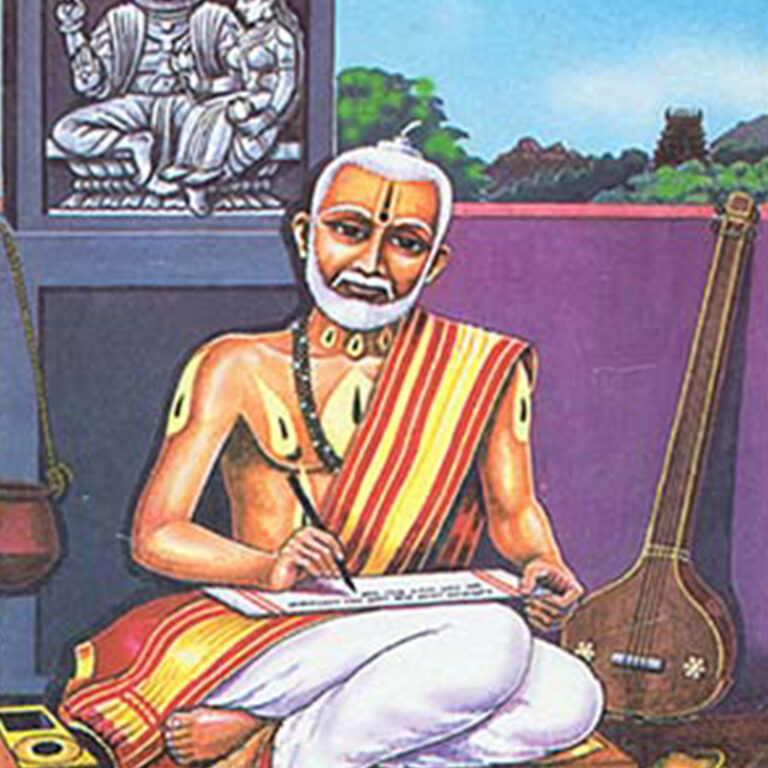
Kaliyugada Kalpataru
Fourth Delight
Sri Vyasa Raja Yati Sarvabhouma
Authored by Raja, S. Gururajacharya
4. Ancestry
Renowned for all arts and virtues, the Shashtika family (a family of sixty-one houses), esteemed as the seat of Saraswati, is highly celebrated in India. This family has been illustrious since ancient times, shining with the brilliance of art, learning, wisdom, generosity, friendliness, and talent. From the earliest times, it has spread flashes of uncommon knowledge, devotion, renunciation, and austerity everywhere. To this day, it remains a highly respected and honored lineage due to its intellectual and material prosperity.
In this vast lineage, many brilliant individuals, likened to suns and moons, have shone with their rays of wisdom and nectarine eloquence, captivating the world. Peacocks skilled in all arts have danced proudly in this family garden. Moreover, in this family pond, many royal swans (paramahamsas) have roamed, sanctifying the world.
In the courtyard of this family, the six philosophies flourished from an early age. The family, adorned with individuals proficient in Vedas, Vedangas, the six philosophies, music, and literature, and shining with virtues like good conduct, character, generosity, valor, and talent, has produced many revered Brahmins known for their adherence to sacred traditions and performance of rituals. No matter how much one describes the grandeur and uniqueness of this family, it will always seem inadequate.
The contributions of this family to the grand repository of global knowledge, religion, culture, and civilization are immense. The valor and fame of this family in history are so significant that they deserve to be written in golden letters. Based on the little available evidence, it is evident that this virtuous family has been a highly renowned lineage in India since the 3rd or 4th century.
Mayuravarma, the founder of the Kadamba dynasty in Karnataka, brought this Shashtik family, who were then residing in Ahichchatra in the Punjab region of northern India, to the southern path. He granted them many agraharas, lands, and professions, arranging for them to settle in the Talagunda village of Shikaripura. According to the Kadambarajavijaya written by Karnaparya, this Shashtik family was invited by the three-eyed Kadamba from Ahichchatra for his Ashwamedha sacrifice around the 4th century AD. He settled them in Talagunda village of Shikaripura, providing them with agraharas and professions, making them helpers in the well-being of his empire.
The sixty-one families of this lineage, originally pure Kannadigas, migrated from Kannada land to various parts of India, gaining fame through their bravery, generosity, and valor, establishing kingdoms or supporting kings, and showcasing the prowess of Kannadigas. Historical studies reveal that these families, originally pure Kannadigas, migrated to Ahichchatra around the 3rd or 4th century, becoming renowned in various fields.
Aware of this, the Kadamba emperor, being a Brahmin himself, brought this famous family to his empire and provided them with all facilities in the Talagunda village of Shikaripura. Initially, there were sixty-four families in this Shashtik lineage. Three families helped the emperor in war, fought valiantly, and attained martyrdom, and one family lineage was lost. Thus, sixty families remained, becoming known as the Shashtiks or the family of sixty. Since then, this group has been respectfully referred to as the Shashtik Marikare.
In the Kadamba dynasty, the Shashtik family members served as court ministers, home ministers, finance ministers, army commanders, cavalry commanders, chief justices, chief treasurers, and in various high positions, serving the Kannada empire as priests, poets, great scholars, artists, and humorists.
Later, this family served in various high positions in the Rashtrakuta, Chalukya, Kalinga, Devagiri, Vijayanagar, Madurai, Tanjore, and Mysore states, making significant contributions to the country and language, gaining fame.
The greatness of the Shashtik family and its members is clearly evident from various sources like "Shashtik Muktakalapa" and "Shashtik Mangalaashaka" by Srivyasajraguru Sarvabhouma, "Shri Vyasarajabhyudaya" by Srivijayeendratirtha, "Shri Vyasarajavijaya" or "Gurugunarathnamala" by Srimad Sudheendratirtha, "Shatvik Vanshavali" by Gangadhar in Marathi, "Aradhya Vanshavali" by Rudrabhatta, "Pallavarajamitra" by Gajanan Kavi, "Kadambrajavijaya" by Karnaparya Kavi, "Shri Vibudhendra Vijaya" by Garudavahana Lakshminarayana, the brother of Srimad Sumateendratirtha in his pre-monastic life, "Chitpavan" by Shri N.G. Chapekar in Marathi, "Saraswat Parinaya" by Raghavendra Kavi, "Shashtik Namavali" and "Shashtik Mahapurusharu" by Bettada Sri Anantacharya, and various inscriptions.